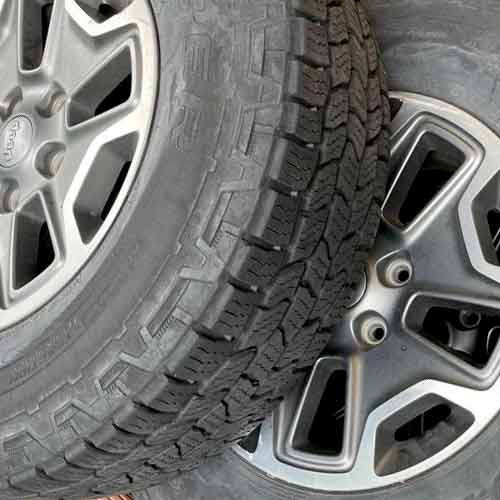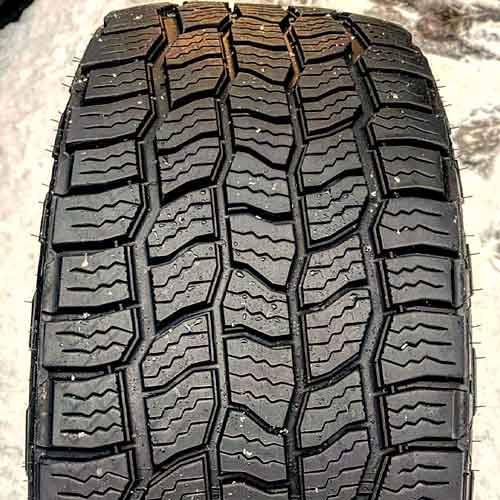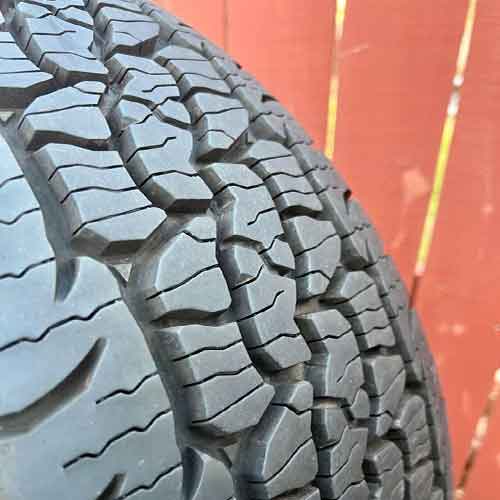Both the BF Goodrich Trail Terrain and the Cooper Discoverer AT3 4S are known for their smooth ride delivery on pavements, yet they do impressively off-road, well, given the terrain isn’t too rugged. But how do these two tires stack up against each other? By the end of this article, all your questions will be answered. Let’s begin!

Being a tire engineer, from my perspective, the Cooper AT3 4S does better on highways, (but you can say it’s dry performance is on par). Though the tire lacks in other on-road areas, and off-road too. The BF Goodrich Trail Terrain on the other side, does better off-road, and on pavements, it’s superior in terms of fuel economy, and on-road comfort (but it’s a little more complicated than that).
Sizes
The Cooper Discoverer AT3 4S, this tire comes with 42 sizes in total (15″ to 22″ rim sizes) and they have following specs.
- Load range: SL and XL
- Speed ratings: T and H
- Weight range: 31 to 45 lbs
- Tread depth range: 12.5 to 14/32″
- All sizes have 3PMSF ratings
- Warranty: 65k miles
On the other side, the BF Goodrich Trail Terrain comes in 15 to 22 inches. They have following specs.
- Speed Ratings: T and H.
- Load Ratings: XL and SL.
- Tread depth: 12.5/32″ on all.
- Weight Range: 30 to 46 lbs.
- 60k Miles warranty.
Tread Design
The Cooper AT3 4S is a tire that truly stands out with its amazing on-road oriented design.

The tire offers a conventional 5 rib design with very similar blocks in all columns.
Still the middle most have lugs with slightly wider geometry, which makes the tire’s on-road traction better, that further gets enhanced by the fact that, all these lugs have reinforced foundations, and they run in pairs (joined up to each other from underneath), and this further provides the tire with highway stability.
The surrounding ribs, although have similar tread features, they additionally give snow vices on the outer edges, making the circumferential grooves, very tough passing and rugged.
The shoulder lugs are slightly bigger, elongated, and staggered towards their outer margins, and although they don’t make as biting of a sidewalls in comparison here, they are still good enough.
Moving towards the other tire, the BF Goodrich Trail Terrain T/A, you get a slightly more aggressive structure.

It’s sidewall lugs are thicker and pasted on a larger surface area. So they are capable of providing amazing off-road grip with lowered air pressure.
Moreover, they also join together with the staggered edges on the shoulder blocks, adding to that aggressiveness.
The shoulder rib is made continuous, and it contains deep in-groove biters, and full depth siping in them.
They make wider circumferential grooves towards the middle, having triangular stone ejectors strategically placed there.
Then there are 3 ribs in the middle, carrying blocks of similar geometry and features.
They have full depth sipes, sharp edges, and reinforced foundations (and they are also connected to each other from underneath, yielding on-road stability).
Fuel Usage
While all-terrain tires may not be as fuel efficient as other tire types, both of these tires are one of the best ones you can get in the category. And even out of them, you get a better fuel economy out of BF Goodrich Trail Terrain.
This tire comes in 2nd in terms of fuel efficiency in my list of top A/T tires, thanks to it’s lighter weight and less tread depth which aren’t prone to flexing. Let me explain.
As the tire corners (for example), it’s tread lugs would want to bend in the opposite direction, and with BFG Trail Terrain, having such shallower (on-road tires like) tread depth, and continuous running shoulder ribs, don’t allow too much energy to get wasted in to the flexing of the lugs, and is rather consumed in to the rolling of the tire as a whole.
The Cooper AT3 4s on the other side, although has a lighter structure too, it’s greater tread depth (on average), combined with lugs having fewer supports still cause it consume more fuel in comparison.
For Your Info: If you are wondering, the most fuel efficient tire in the category of A/T tires, is the Firestone Destination AT2 (review).
Tread Life
Although one would think with BF Goodrich Trail Terrain having a better fuel efficiency would also show up with superior tread life, that’s not really the case.
That’s because with smaller tread depth, the tire burns down to 2/32″ faster in comparison. Whereas the Cooper Discoverer AT3 4S with tread depth going up to 14/32″ provides better resistance to tread wear.
Though the margin is very low, that’s why when it comes to warranties, there’s only a difference of 5k miles. The BFG gives it’s tires with 60k miles warranty, whereas the Cooper comes at 65k.
Also Read-
Increase tread life: https://tiredriver.com/how-to-increase-tread-life-on-tires/
Ride Quality
The quality of the ride depends on two main things, in my books.
- The overall noise, the tread makes.
- And the bumps absorption capabilities of a tire.
Let me discuss them both.
Tread Noise
The volume of the tire’s noise is influenced by the amount of air that passes through its tread. It hits around the walls, and the impact creates what you call “tread noise”.
But since most of that air comes in form the shoulder voids, with continuous running rib, the BF Goodrich Trail Terrain kills the noise at the source.
Cooper Discoverer AT3 4S on the other side, features Whisper Grooves, where it places connectors between the shoulder blocks blocking the inward air flow. But still its tread allows more air to come in, making the tire louder in comparison.
Bumps Absorption
Noise is just as important as the tire’s ability to cushion road imperfections. And here the Cooper AT3 gets to have an upper hand in its case.
This is because this tire has an overall softer compound, and with greater tread depth, it offers a thicker layer of rubber between you and the bumps.
Durability
The resilience of off-road tires is of utmost importance when navigating rugged and unforgiving terrains, as they are susceptible to damage from sharp objects and rough surfaces. In particular, the sidewalls of such tires are vulnerable to punctures and cuts.
And so since the BF Goodrich Trail Terrain provides thicker sidewall lugs, it’s provides more robustness to the bead area.
Other than that, internally both tires are the same. They give you 2 ply polyester casing, 2 broad steel belts which covers the tread area, and a single ply nylon reinforcements.
Dry Performance
While driving on paved roads, several factors contribute to optimal performance, including dry grip, handling stability, and steering feedback.
Dry Grip
All-terrain A/T tires may struggle to provide adequate traction on dry roads due to their bolder design, though it’s not the case when it comes to these two tires over here.
As both of them show up with equal dry performance values. Let me explain why.
So dry/directional grip depends on two main factors, tread structure (which also includes, tread depth, and weight), and the tire’s footprint. And since it’s a grip while moving straight, it gets measured with braking distances.
The Cooper AT3 does better with it’s longitudinal arrangement of the blocks (which make better contact with the road while moving directionally), whereas, the BF Goodrich Trail Terrain show similar efficacy, with it’s biters in multiple directions and full depth siping.
These sipes are capable of providing in groove biters, and this adds to the tire’s overall stopping abilities.
So I rated both these tires equal. They are both really good daily drivers.
Dry Handling
The handling characteristics of a tire are largely determined by the outer tread area, as during cornering, it gets to have a largest weight concentrations on it.
That’s why with a continuous shoulder structure, the BF Goodrich Trail Terrain provides better efficacy, as it supplies consistent rubber to road contact from there.
On the other hand, the Cooper Discoverer AT3 4S although has pretty packed up shoulder lugs, they still can’t have the similar contact with the surface, so overall handling gets limited here.
Furthermore, although the tire has ridges in between the shoulder lugs, keeping them firm, they still get to flex more in comparison, and this decreases the overall steering sensitivity, and with it response times.
Wet Traction
Wet performance is divided into two dimensions: wet traction and hydroplaning resistance. So I am going to talk about them both one by one below.
Wet Grip
Wet grip is influenced by the compound stiffness and sipe density + structure of a tire. And considering all, it can be seen why BF Goodrich Trail Terrain lacks here in comparison.
This is mainly because it’s sipes are just laterally oriented, and they get stiffer as the tire corners, brakes or accelerates. This is significant because these sipes literally squeeze/expand to suck water particles in them, while the rest of it flows out through the grooves.
On the other side, the Cooper Discoverer AT3 4S yields superior performance with it’s more in number sipes, having an interlocking structure. So for wet traction, this all-terrain tire is really worth it.
Moreover, this tire additionally adds to it’s overall wet grip, with the following.
Hydroplaning
Aquaplaning, also known as hydroplaning, occurs when a tire is unable to clear water from its tread quickly enough and begins to float, resulting in a loss of traction.
This is avoided with grooves, which channel the major portion of the water out, but since the BF Goodrich Trail Terrain has closed up outer ribs (as they are continuous running), the tire does not allow water to leave out sideways.
And with less water getting out, there’s more left behind, which comes in contact with its less effective sipes.
That’s why Cooper Discoverer AT3 4S with better hydroplaning resistance further adds to overall wet traction.
Winter Capabilities
Where the BF Goodrich Trail Terrain lacked so much on wet roads, it makes up for it on snowy terrains. This is because the sipes, and biters on it’s tread are better optimized for snow.
With full depth siping and interconnected web of grooves, the tire yields better efficacy in grabbing snow particles in it’s grooves and sipes, and making snow to snow contact with it.
This produces better friction, as snowflakes stick to each other more, compared to rubber (that’s why we have the term, the snowball effect).
Cooper Discoverer AT3 4S, on the other side, although has a lot of wave-like siping, and snow vices on outer grooves, it still lacks in supping enough biters, to grip as much as its competitor.
Also Read –
Are A/T tires good in Snow: https://tiredriver.com/are-all-terrain-tires-good-in-snow/
Rugged Terrain Performance
Off-road tires should have strong self-cleaning abilities and durability to perform well on various terrain types. And although both of these tires are not so off-road oriented, I still tested them out in the following areas.
Sandy Dunes
Sand is a unique terrain that requires tires with a large contact patch, so that’s why I am going to go with BF Goodrich Trail Terrain here.
This is because for one, its sidewall lugs are covering a larger surface area, and two, its’ continuous running shoulder ribs, account for smoother outer edges that are less prone to digging.
Cooper Discoverer AT3 4S on the other side, does not offer good enough lugs towards sides (though it’s XLT variant is a good option for that).
For Your Info: With larger sidewall lugs, you get greater contact patch with the sand, upon lowering the air pressure. And this results in greater floating abilities and traction.
On Muddy Terrains
On muddy terrain, you need self cleaning grooves, and lugs that could generate forward momentum.
And although both of these tires are not suitable for deeper tracks here, out of them, the Cooper Discoverer AT3 4S still does better on lighter terrains.
This is because unlike the BF Goodrich Trail Terrain, it does not offer packed up shoulder lugs, and allows mud to leave out sideways.
On Rocks
On rocky terrains, tires must possess durability and strong traction, particularly on the sidewalls, to handle rough terrain and climbing.
BF Goodrich Trail Terrain is a better tire here, as it features interconnected in groove biters form the middle where full depth sipes also split open the blocks and provide further biting efficacy.
Cooper Discoverer AT3 4S has a very blocky design, and it’s sidewall lugs aren’t that biting either, even with lowered air pressure, so this tire takes the back seat here.
Take Home Points
Overall it all comes down to this.
Cooper Discoverer AT3 4S although gives you a great wet traction, and tread life, it lacks in fuel economy and on-road comfort (in terms of noise).
BF Goodrich Trail Terrain on the other side, does well, with the rest, but wet traction, and off-road it’s great on all terrains, but lacks in mud, comparatively.
Note that this is the short summary, if you are skipping on the above explanation, there’s a lot of stuff you are missing out on.